EU Law Info on EU — www.
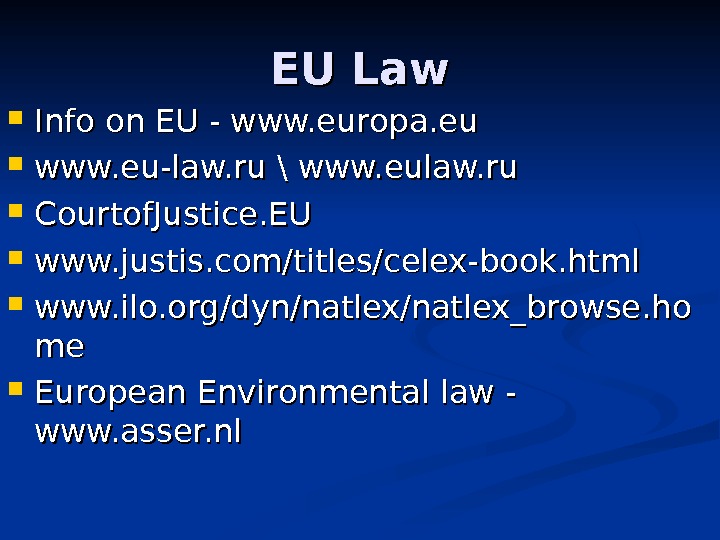
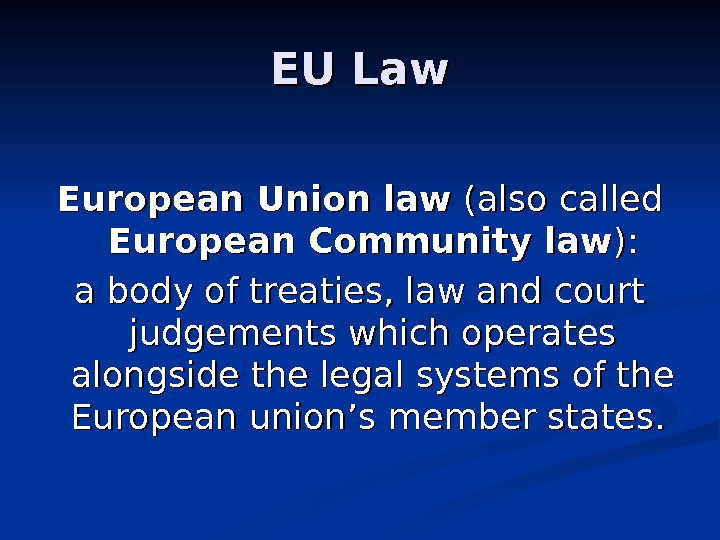
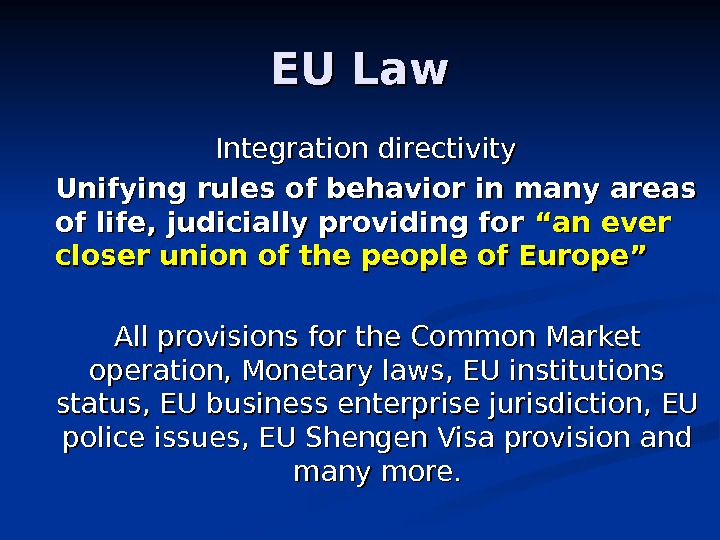
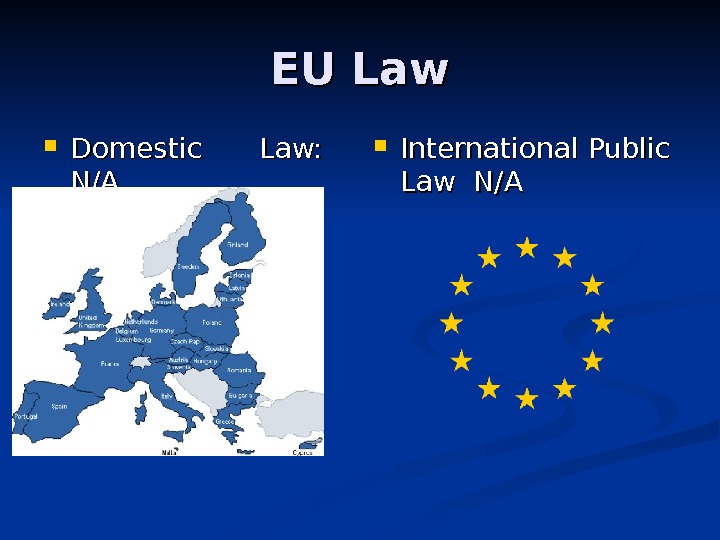
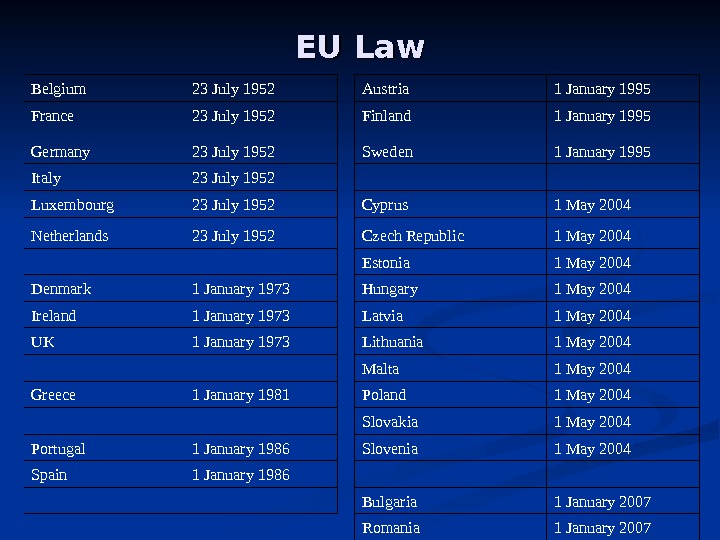
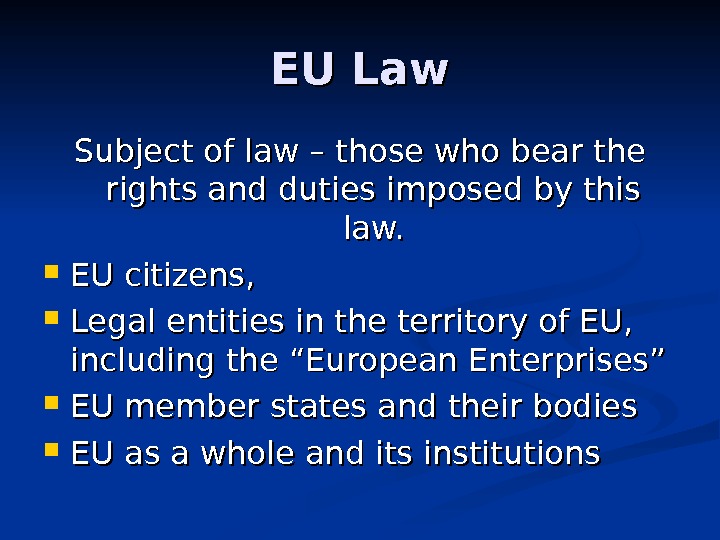
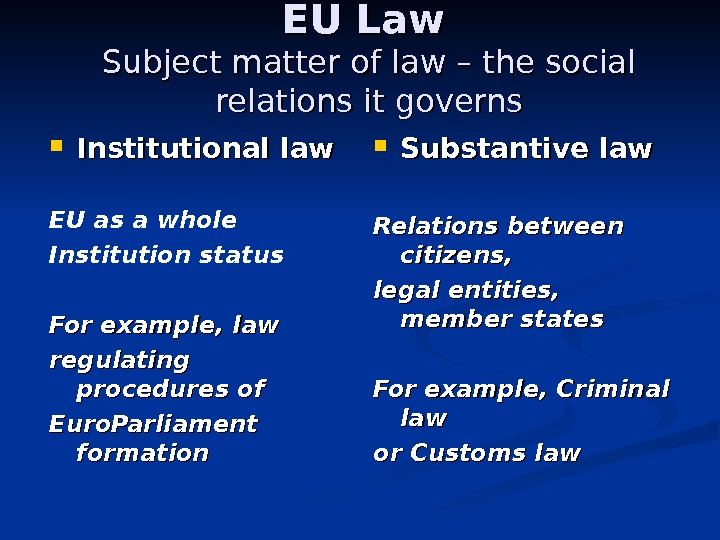

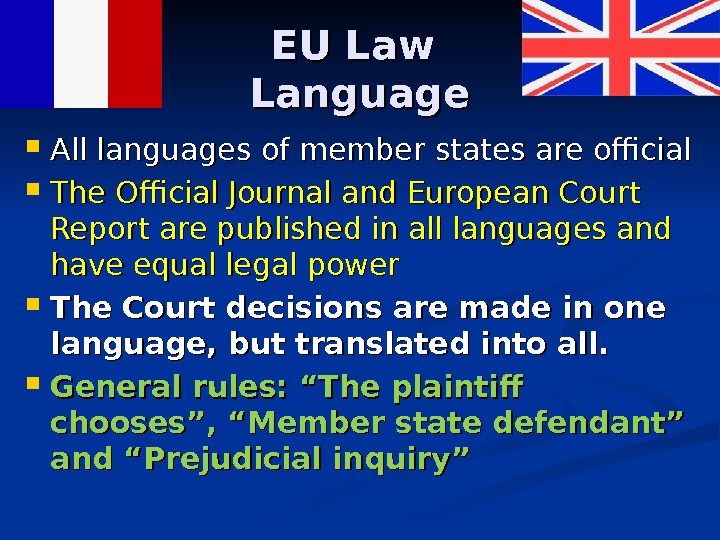
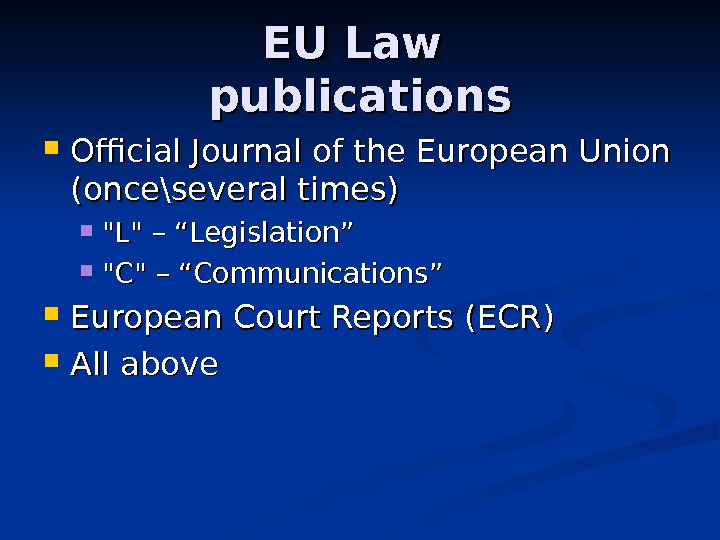
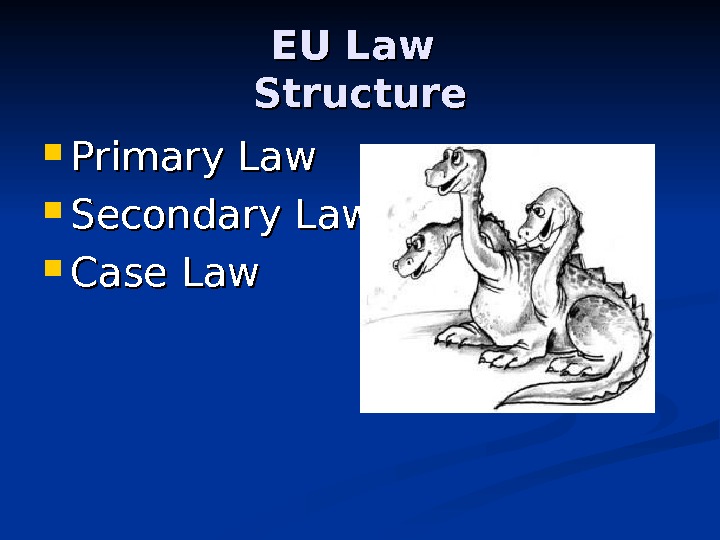
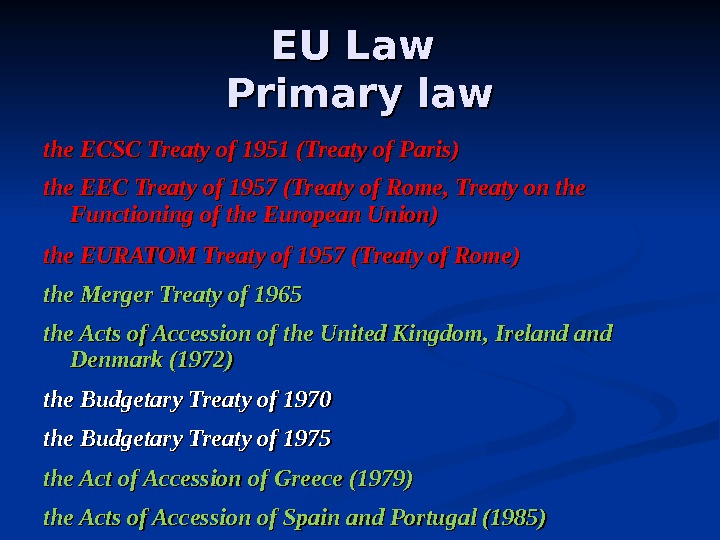
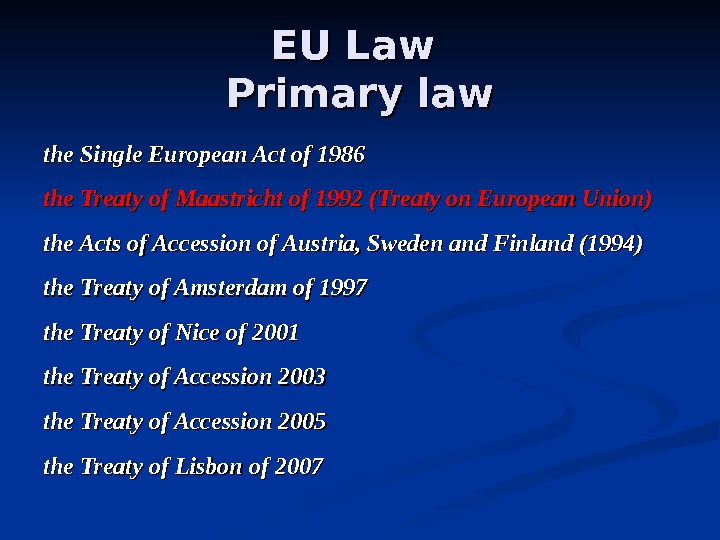
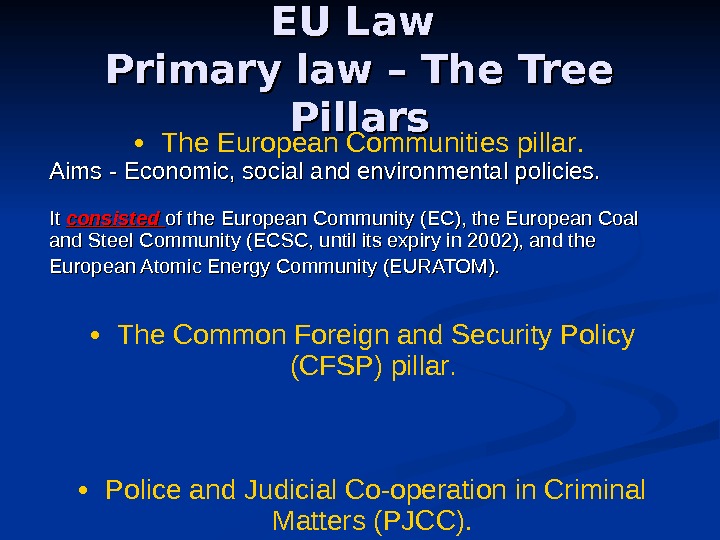
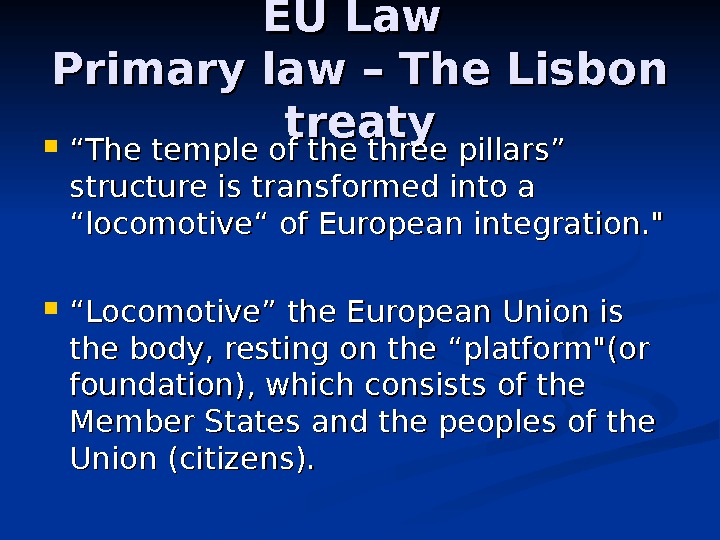
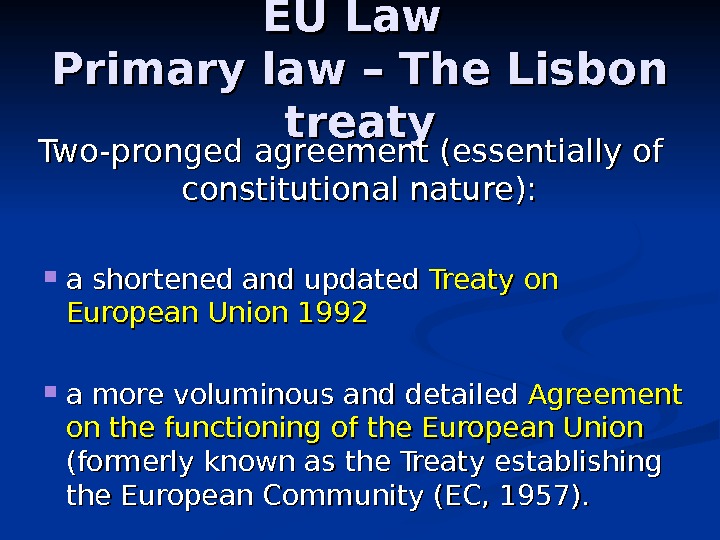
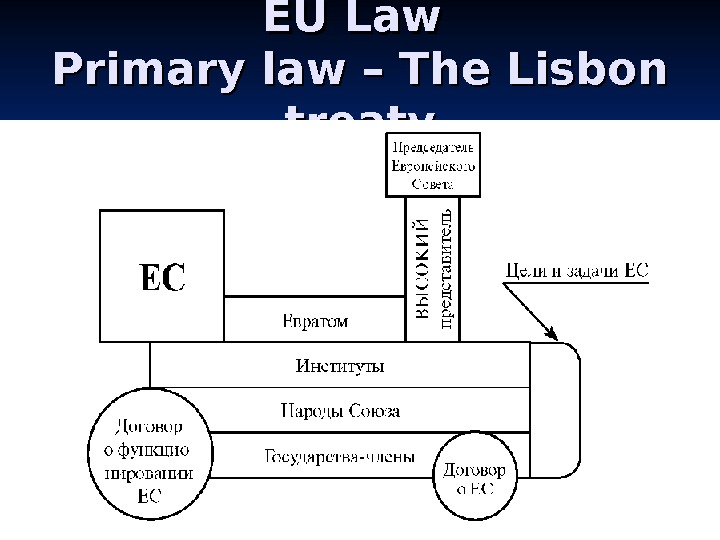
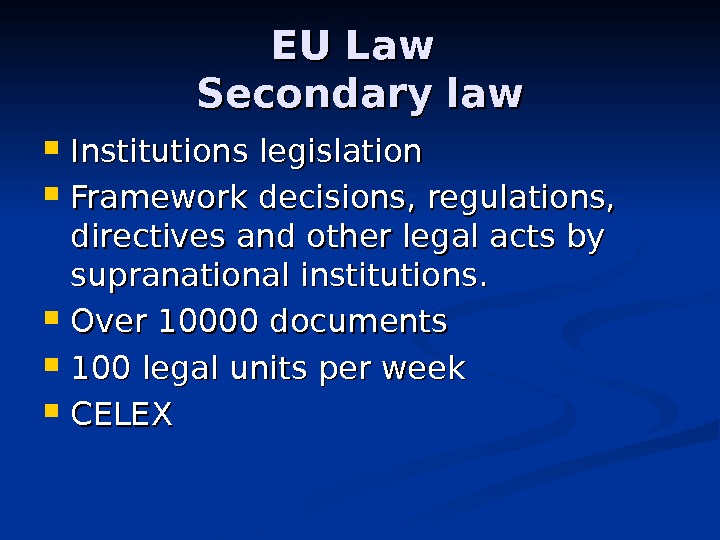
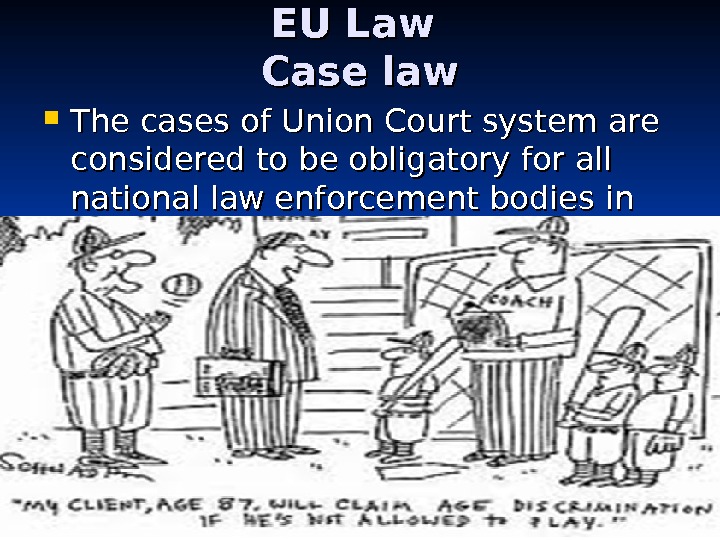
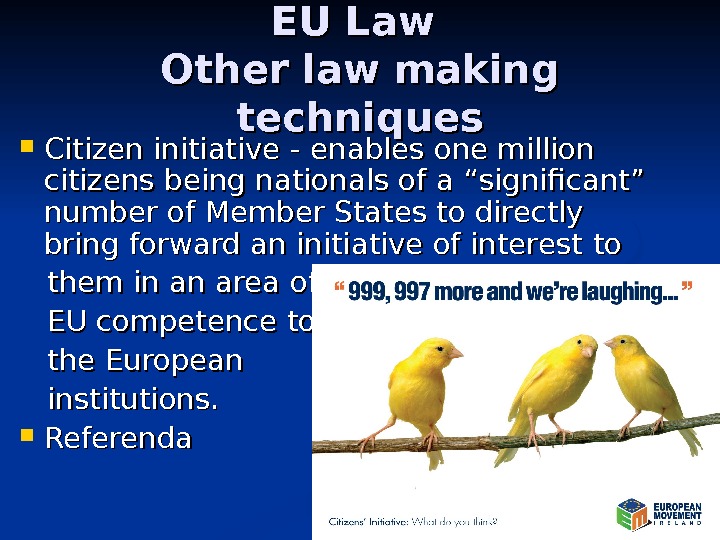
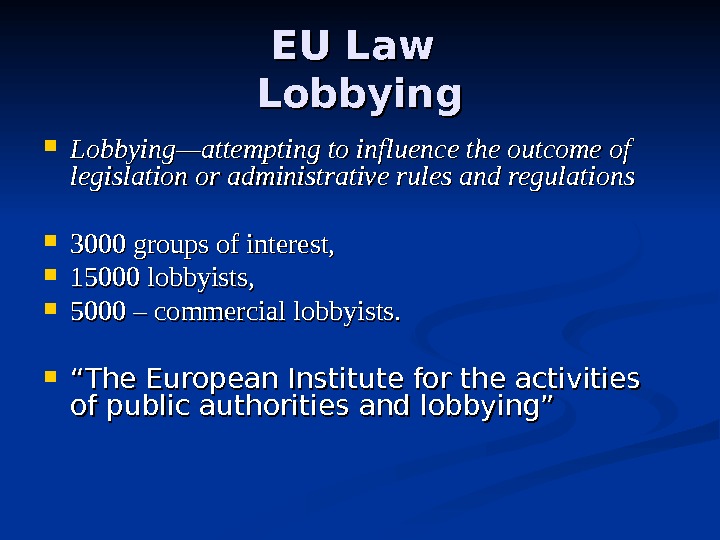
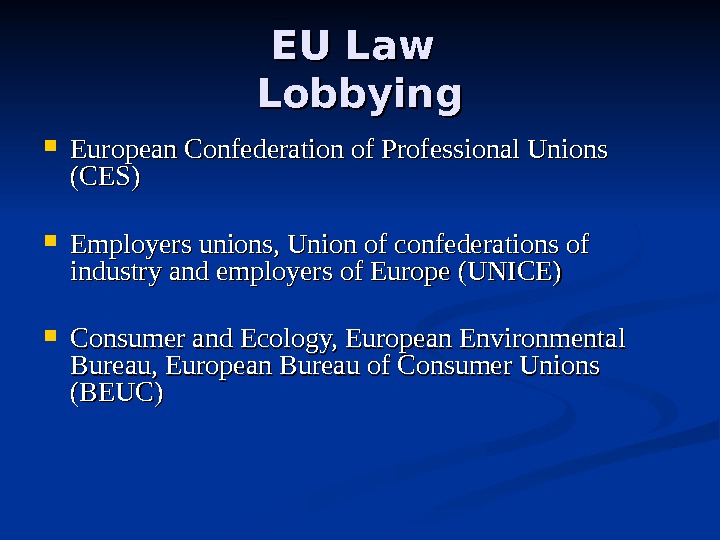

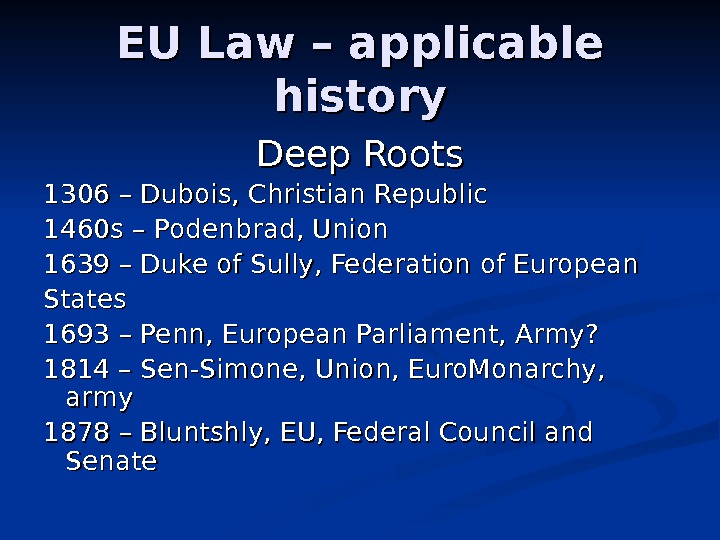
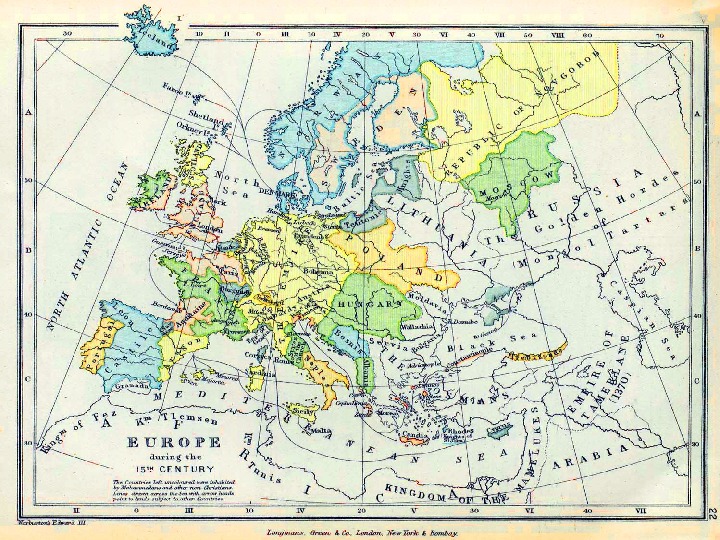


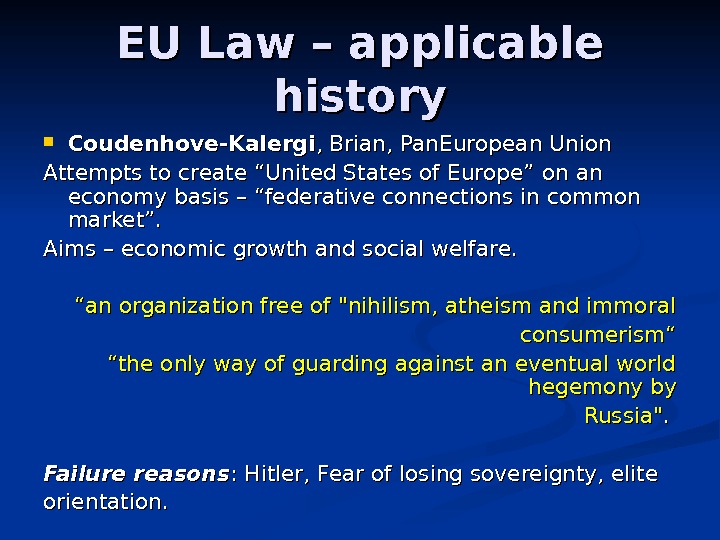
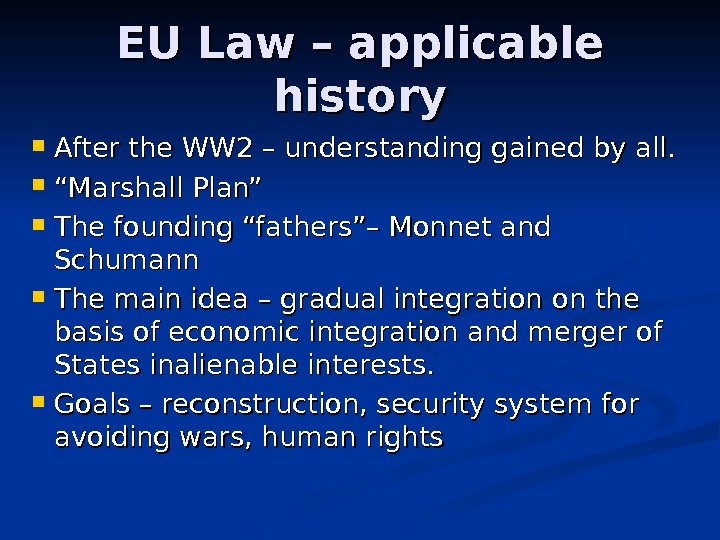
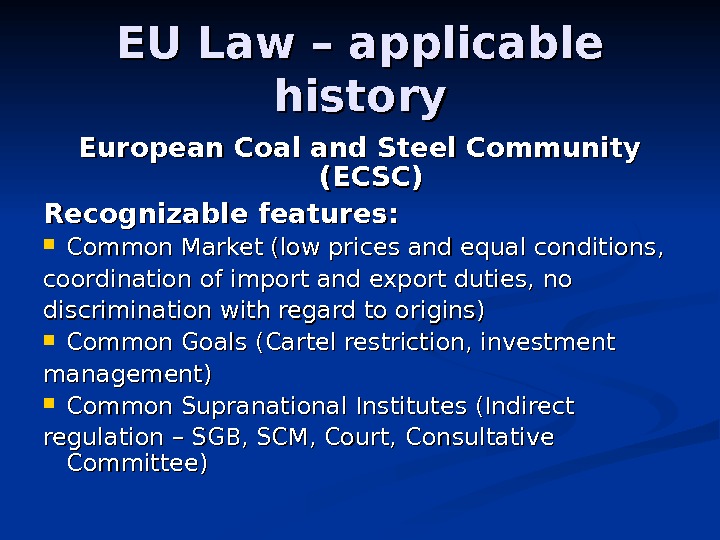
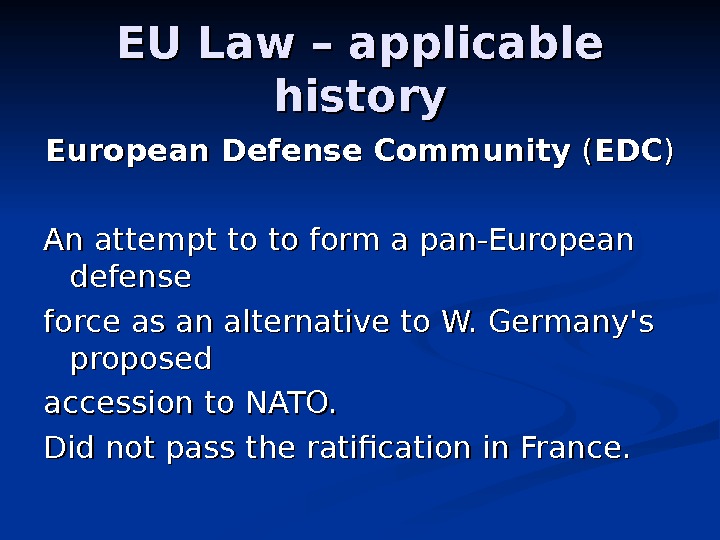
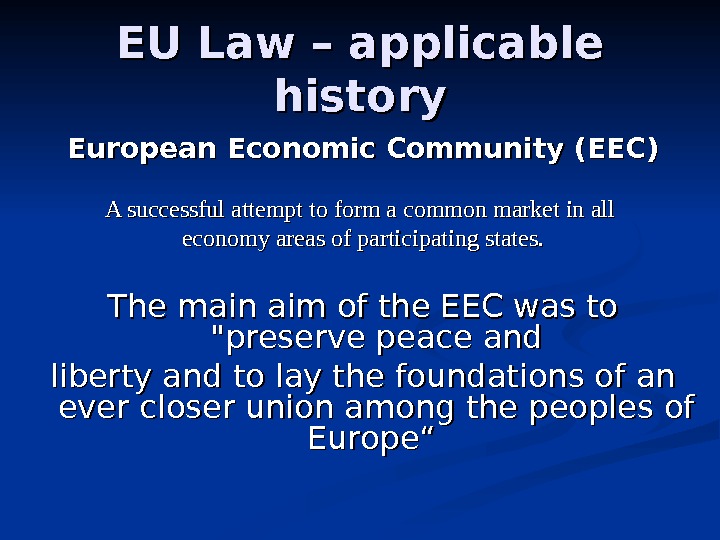
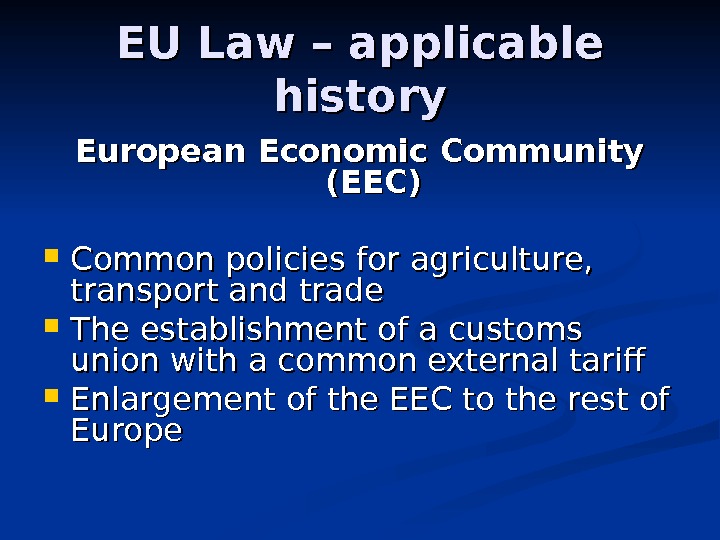
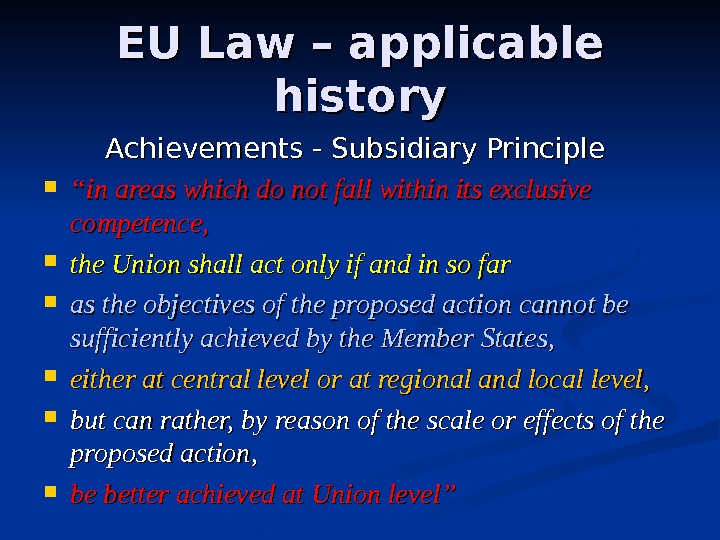
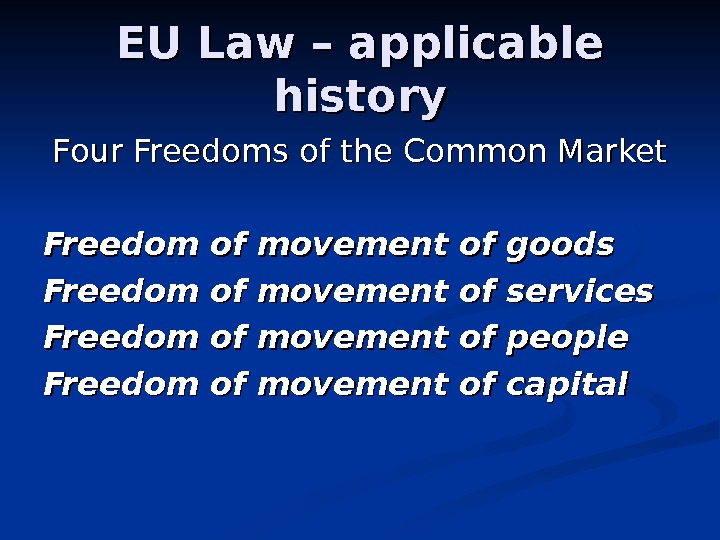
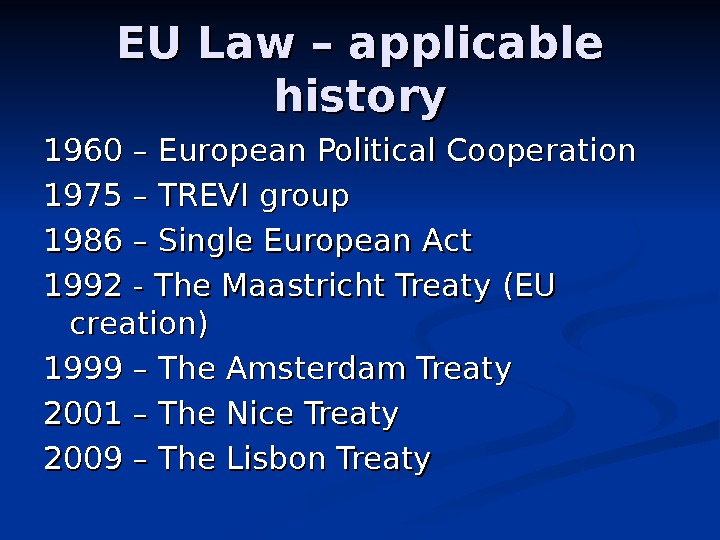
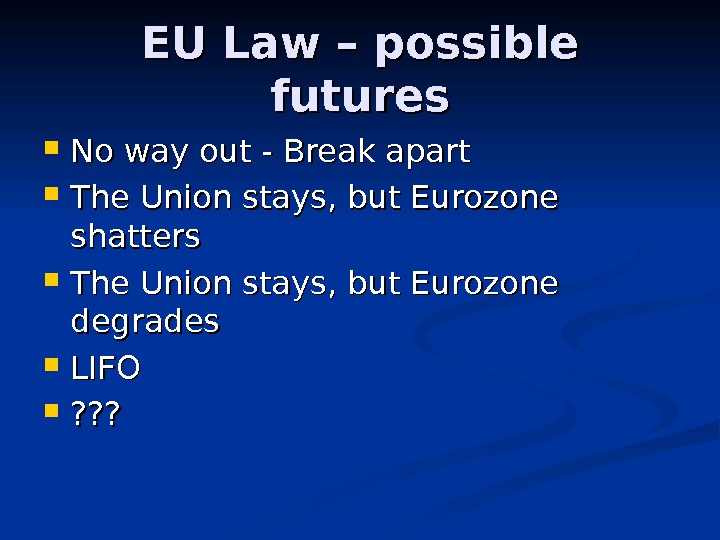
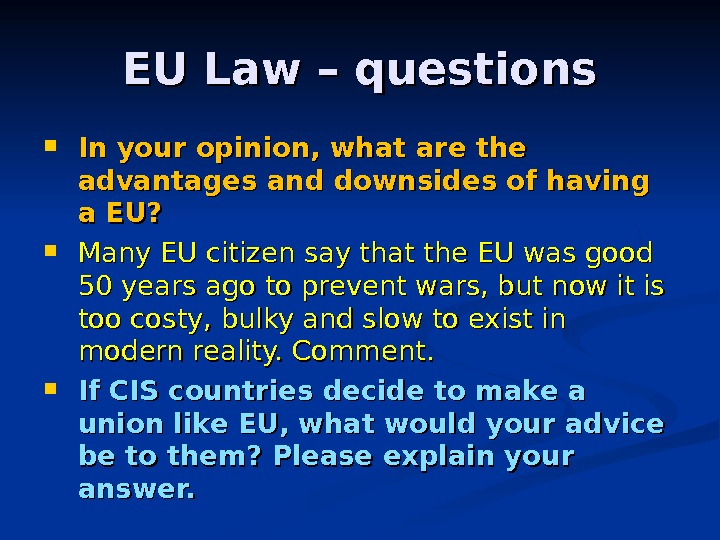
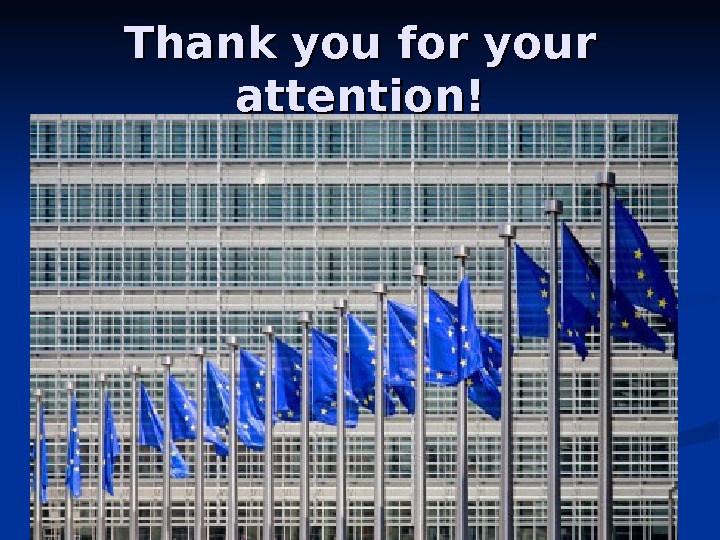
- Размер: 4.7 Mегабайта
- Количество слайдов: 39
Описание презентации EU Law Info on EU — www. по слайдам
 EU Law Info on EU — www. europa. eu www. eu-law. ru \ www. eulaw. ru Courtof. Justice. EU www. justis. com/titles/celex-book. html www. ilo. org/dyn/natlex/natlex_browse. ho meme European Environmental law — www. asser. nl
EU Law Info on EU — www. europa. eu www. eu-law. ru \ www. eulaw. ru Courtof. Justice. EU www. justis. com/titles/celex-book. html www. ilo. org/dyn/natlex/natlex_browse. ho meme European Environmental law — www. asser. nl
 EU Law European Union law ( ( also called European Community law )) : : a body of treaties, law and court judgements which operates alongside the legal systems of the European union’s member states.
EU Law European Union law ( ( also called European Community law )) : : a body of treaties, law and court judgements which operates alongside the legal systems of the European union’s member states.
 EU Law Integration directivity Unifying rules of behavior in many areas of life, judicially providing for “an ever closer union of the people of Europe” All provisions for the Common Market operation, Monetary laws, EU institutions status, EU business enterprise jurisdiction, EU police issues, EU Shengen Visa provision and many more.
EU Law Integration directivity Unifying rules of behavior in many areas of life, judicially providing for “an ever closer union of the people of Europe” All provisions for the Common Market operation, Monetary laws, EU institutions status, EU business enterprise jurisdiction, EU police issues, EU Shengen Visa provision and many more.
 EU Law Domestic Law: N/AN/A International Public Law N/
EU Law Domestic Law: N/AN/A International Public Law N/
 EU Law Belgium 23 July 1952 Austria 1 January 1995 France 23 July 1952 Finland 1 January 1995 Germany 23 July 1952 Sweden 1 January 1995 Italy 23 July 1952 Luxembourg 23 July 1952 Cyprus 1 May 2004 Netherlands 23 July 1952 Czech Republic 1 May 2004 Estonia 1 May 2004 Denmark 1 January 1973 Hungary 1 May 2004 Ireland 1 January 1973 Latvia 1 May 2004 UK 1 January 1973 Lithuania 1 May 2004 Malta 1 May 2004 Greece 1 January 1981 Poland 1 May 2004 Slovakia 1 May 2004 Portugal 1 January 1986 Slovenia 1 May 2004 Spain 1 January 1986 Bulgaria 1 January 2007 Romania 1 January
EU Law Belgium 23 July 1952 Austria 1 January 1995 France 23 July 1952 Finland 1 January 1995 Germany 23 July 1952 Sweden 1 January 1995 Italy 23 July 1952 Luxembourg 23 July 1952 Cyprus 1 May 2004 Netherlands 23 July 1952 Czech Republic 1 May 2004 Estonia 1 May 2004 Denmark 1 January 1973 Hungary 1 May 2004 Ireland 1 January 1973 Latvia 1 May 2004 UK 1 January 1973 Lithuania 1 May 2004 Malta 1 May 2004 Greece 1 January 1981 Poland 1 May 2004 Slovakia 1 May 2004 Portugal 1 January 1986 Slovenia 1 May 2004 Spain 1 January 1986 Bulgaria 1 January 2007 Romania 1 January
 EU Law Subject of law – those who bear the rights and duties imposed by this law. EU citizens, Legal entities in the territory of EU, including the “European Enterprises” EU member states and their bodies EU as a whole and its institutions
EU Law Subject of law – those who bear the rights and duties imposed by this law. EU citizens, Legal entities in the territory of EU, including the “European Enterprises” EU member states and their bodies EU as a whole and its institutions
 EU Law Subject matter of law – the social relations it governs Institutional law EU as a whole Institution status For example, law regulating procedures of Euro. Parliament formation Substantive law Relations between citizens, legal entities, member states For example, Criminal lawlaw or Customs law
EU Law Subject matter of law – the social relations it governs Institutional law EU as a whole Institution status For example, law regulating procedures of Euro. Parliament formation Substantive law Relations between citizens, legal entities, member states For example, Criminal lawlaw or Customs law
 EU Law Regulating methods Unification Single rules of behavior throughout the EU Harmonizatio nn Basic legislation creation in order to “bring together” different legal systems
EU Law Regulating methods Unification Single rules of behavior throughout the EU Harmonizatio nn Basic legislation creation in order to “bring together” different legal systems
 EU Law Language All languages of member states are official The Official Journal and European Court Report are published in all languages and have equal legal power The Court decisions are made in one language, but translated into all. General rules: “The plaintiff chooses”, “Member state defendant” and “Prejudicial inquiry”
EU Law Language All languages of member states are official The Official Journal and European Court Report are published in all languages and have equal legal power The Court decisions are made in one language, but translated into all. General rules: “The plaintiff chooses”, “Member state defendant” and “Prejudicial inquiry”
 EU Law publications Official Journal of the European Union (once\several times) «L» – ““ Legislation ”” «С» – ““ Communications ”” European Court Reports (( ECRECR )) All above
EU Law publications Official Journal of the European Union (once\several times) «L» – ““ Legislation ”” «С» – ““ Communications ”” European Court Reports (( ECRECR )) All above
 EU Law Structure Primary Law Secondary Law Case Law
EU Law Structure Primary Law Secondary Law Case Law
 EU Law Primary law the ECSC Treaty of 1951 (Treaty of Paris) the EEC Treaty of 1957 (Treaty of Rome, Treaty on the Functioning of the European Union) the EURATOM Treaty of 1957 (Treaty of Rome) the Merger Treaty of 1965 the Acts of Accession of the United Kingdom, Ireland and Denmark (1972) the Budgetary Treaty of 1970 the Budgetary Treaty of 1975 the Act of Accession of Greece (1979) the Acts of Accession of Spain and Portugal (1985)
EU Law Primary law the ECSC Treaty of 1951 (Treaty of Paris) the EEC Treaty of 1957 (Treaty of Rome, Treaty on the Functioning of the European Union) the EURATOM Treaty of 1957 (Treaty of Rome) the Merger Treaty of 1965 the Acts of Accession of the United Kingdom, Ireland and Denmark (1972) the Budgetary Treaty of 1970 the Budgetary Treaty of 1975 the Act of Accession of Greece (1979) the Acts of Accession of Spain and Portugal (1985)
 EU Law Primary law the Single European Act of 1986 the Treaty of Maastricht of 1992 (Treaty on European Union) the Acts of Accession of Austria, Sweden and Finland (1994) the Treaty of Amsterdam of 1997 the Treaty of Nice of 2001 the Treaty of Accession 2003 the Treaty of Accession 2005 the Treaty of Lisbon of
EU Law Primary law the Single European Act of 1986 the Treaty of Maastricht of 1992 (Treaty on European Union) the Acts of Accession of Austria, Sweden and Finland (1994) the Treaty of Amsterdam of 1997 the Treaty of Nice of 2001 the Treaty of Accession 2003 the Treaty of Accession 2005 the Treaty of Lisbon of
 EU Law Primary law – The Tree Pillars • The European Communities pillar. Aims — E conomic, social and environmental policies. It It consist eded of the European Community (EC), the European Coal and Steel Community (ECSC, until its expiry in 2002), and the European Atomic Energy Community (EURATOM). • The Common Foreign and Security Policy (CFSP) pillar. • Police and Judicial Co-operation in Criminal Matters (PJCC).
EU Law Primary law – The Tree Pillars • The European Communities pillar. Aims — E conomic, social and environmental policies. It It consist eded of the European Community (EC), the European Coal and Steel Community (ECSC, until its expiry in 2002), and the European Atomic Energy Community (EURATOM). • The Common Foreign and Security Policy (CFSP) pillar. • Police and Judicial Co-operation in Criminal Matters (PJCC).
 EU Law Primary law – The Lisbon treaty ““ The temple of the three pillars” structure is transformed into a “locomotive“ of European integration. » ““ Locomotive” the European Union is the body, resting on the “platform»(or foundation), which consists of the Member States and the peoples of the Union (citizens).
EU Law Primary law – The Lisbon treaty ““ The temple of the three pillars” structure is transformed into a “locomotive“ of European integration. » ““ Locomotive” the European Union is the body, resting on the “platform»(or foundation), which consists of the Member States and the peoples of the Union (citizens).
 EU Law Primary law – The Lisbon treaty Two-pronged agreement (essentially of constitutional nature): a shortened and updated Treaty on European Union 1992 a more voluminous and detailed Agreement on the functioning of the European Union (formerly known as the Treaty establishing the European Community (EC, 1957).
EU Law Primary law – The Lisbon treaty Two-pronged agreement (essentially of constitutional nature): a shortened and updated Treaty on European Union 1992 a more voluminous and detailed Agreement on the functioning of the European Union (formerly known as the Treaty establishing the European Community (EC, 1957).
 EU Law Primary law – The Lisbon treaty
EU Law Primary law – The Lisbon treaty
 EU Law Secondary law Institutions legislation Framework decisions, regulations, directives and other legal acts by supranational institutions. Over 10000 documents 100 legal units per week СС ELEX
EU Law Secondary law Institutions legislation Framework decisions, regulations, directives and other legal acts by supranational institutions. Over 10000 documents 100 legal units per week СС ELEX
 EU Law Case law The cases of Union Court system are considered to be obligatory for all national law enforcement bodies in the EU.
EU Law Case law The cases of Union Court system are considered to be obligatory for all national law enforcement bodies in the EU.
 EU Law Other law making techniques Citizen initiative — enables one million citizens being nationals of a ““ significant ”” number of Member States to directly bring forward an initiative of interest to to them in an area of EU competence to to the European institutions. Referenda
EU Law Other law making techniques Citizen initiative — enables one million citizens being nationals of a ““ significant ”” number of Member States to directly bring forward an initiative of interest to to them in an area of EU competence to to the European institutions. Referenda
 EU Law Lobbying—attempting to influence the outcome of legislation or administrative rules and regulations 3000 groups of interest, 15000 lobbyists, 5000 – commercial lobbyists. ““ The European Institute for the activities of public authorities and lobbying”
EU Law Lobbying—attempting to influence the outcome of legislation or administrative rules and regulations 3000 groups of interest, 15000 lobbyists, 5000 – commercial lobbyists. ““ The European Institute for the activities of public authorities and lobbying”
 EU Law Lobbying European Confederation of Professional Unions (CES) Employers unions, Union of confederations of industry and employers of Europe (UNICE) Consumer and Ecology, European Environmental Bureau, European Bureau of Consumer Unions (BEUC)
EU Law Lobbying European Confederation of Professional Unions (CES) Employers unions, Union of confederations of industry and employers of Europe (UNICE) Consumer and Ecology, European Environmental Bureau, European Bureau of Consumer Unions (BEUC)
 EU Law — Conditions Developed economies, Economic, social, political, legal and cultural environment proximity Small territory size emphasized the narrowness of national borders and internal markets Protection ideas
EU Law — Conditions Developed economies, Economic, social, political, legal and cultural environment proximity Small territory size emphasized the narrowness of national borders and internal markets Protection ideas
 EU Law – applicable history Deep Roots 1306 – Dubois, Christian Republic 1460 s – Podenbrad, Union 1639 – Duke of Sully, Federation of European States 1693 – Penn, European Parliament, Army? 1814 – Sen-Simone, Union, Euro. Monarchy, army 1878 – Bluntshly, EU, Federal Council and Senate
EU Law – applicable history Deep Roots 1306 – Dubois, Christian Republic 1460 s – Podenbrad, Union 1639 – Duke of Sully, Federation of European States 1693 – Penn, European Parliament, Army? 1814 – Sen-Simone, Union, Euro. Monarchy, army 1878 – Bluntshly, EU, Federal Council and Senate



 EU Law – applicable history Coudenhove-Kalergi , Brian, Pan. European Union Attempts to create “United States of Europe” on an economy basis – “federative connections in common market”. Aims – economic growth and social welfare. ““ an organization free of «nihilism, atheism and immoral consumerism“ ““ the only way of guarding against an eventual world hegemony by Russia». . Failure reasons : Hitler, Fear of losing sovereignty, elite orientation.
EU Law – applicable history Coudenhove-Kalergi , Brian, Pan. European Union Attempts to create “United States of Europe” on an economy basis – “federative connections in common market”. Aims – economic growth and social welfare. ““ an organization free of «nihilism, atheism and immoral consumerism“ ““ the only way of guarding against an eventual world hegemony by Russia». . Failure reasons : Hitler, Fear of losing sovereignty, elite orientation.
 EU Law – applicable history After the WW 2 – understanding gained by all. ““ Marshall Plan” The founding “fathers”– Monnet and Schumann The main idea – gradual integration on the basis of economic integration and merger of States inalienable interests. Goals – reconstruction, security system for avoiding wars, human rights
EU Law – applicable history After the WW 2 – understanding gained by all. ““ Marshall Plan” The founding “fathers”– Monnet and Schumann The main idea – gradual integration on the basis of economic integration and merger of States inalienable interests. Goals – reconstruction, security system for avoiding wars, human rights
 EU Law – applicable history European Coal and Steel Community (ECSC) Recognizable features : : Common Market (low prices and equal conditions, coordination of import and export duties, no discrimination with regard to origins) Common Goals (Cartel restriction, investment management) Common Supranational Institutes (Indirect regulation – SGB, SCM, Court, Consultative Committee ))
EU Law – applicable history European Coal and Steel Community (ECSC) Recognizable features : : Common Market (low prices and equal conditions, coordination of import and export duties, no discrimination with regard to origins) Common Goals (Cartel restriction, investment management) Common Supranational Institutes (Indirect regulation – SGB, SCM, Court, Consultative Committee ))
 EU Law – applicable history European Defense Community ( ( EDCEDC ) ) An attempt to to form a pan-European defense force as an alternative to W. W. Germany’s proposed accession to NATO. Did not pass the ratification in France.
EU Law – applicable history European Defense Community ( ( EDCEDC ) ) An attempt to to form a pan-European defense force as an alternative to W. W. Germany’s proposed accession to NATO. Did not pass the ratification in France.
 EU Law – applicable history European Economic Community (EEC) A successful attempt to form a common market in all economy areas of participating states. The main aim of the EEC was to «preserve peace and liberty and to lay the foundations of an ever closer union among the peoples of Europe“
EU Law – applicable history European Economic Community (EEC) A successful attempt to form a common market in all economy areas of participating states. The main aim of the EEC was to «preserve peace and liberty and to lay the foundations of an ever closer union among the peoples of Europe“
 EU Law – applicable history European Economic Community (EEC) Common policies for agriculture, transport and trade The establishment of a customs union with a common external tariff Enlargement of the EEC to the rest of Europe
EU Law – applicable history European Economic Community (EEC) Common policies for agriculture, transport and trade The establishment of a customs union with a common external tariff Enlargement of the EEC to the rest of Europe
 EU Law – applicable history Achievements — Subsidiary Principle ““ in areas which do not fall within its exclusive competence, the Union shall act only if and in so far as the objectives of the proposed action cannot be sufficiently achieved by the Member States, either at central level or at regional and local level, but can rather, by reason of the scale or effects of the proposed action, be better achieved at Union level ””
EU Law – applicable history Achievements — Subsidiary Principle ““ in areas which do not fall within its exclusive competence, the Union shall act only if and in so far as the objectives of the proposed action cannot be sufficiently achieved by the Member States, either at central level or at regional and local level, but can rather, by reason of the scale or effects of the proposed action, be better achieved at Union level ””
 EU Law – applicable history Four Freedoms of the Common Market Freedom of movement of goods Freedom of movement of services Freedom of movement of people Freedom of movement of capital
EU Law – applicable history Four Freedoms of the Common Market Freedom of movement of goods Freedom of movement of services Freedom of movement of people Freedom of movement of capital
 EU Law – applicable history 1960 – European Political Cooperation 1975 – TREVI group 1986 – Single European Act 1992 — The Maastricht Treaty (EU creation) 1999 – The Amsterdam Treaty 2001 – The Nice Treaty 2009 – The Lisbon Treaty
EU Law – applicable history 1960 – European Political Cooperation 1975 – TREVI group 1986 – Single European Act 1992 — The Maastricht Treaty (EU creation) 1999 – The Amsterdam Treaty 2001 – The Nice Treaty 2009 – The Lisbon Treaty
 EU Law – possible futures No way out — Break apart The Union stays, but Eurozone shatters The Union stays, but Eurozone degrades LIFO ? ? ?
EU Law – possible futures No way out — Break apart The Union stays, but Eurozone shatters The Union stays, but Eurozone degrades LIFO ? ? ?
 EU Law – questions In your opinion, what are the advantages and downsides of having a EU? Many EU citizen say that the EU was good 50 years ago to prevent wars, but now it is too costy, bulky and slow to exist in modern reality. Comment. If CIS countries decide to make a union like EU, what would your advice be to them? Please explain your answer.
EU Law – questions In your opinion, what are the advantages and downsides of having a EU? Many EU citizen say that the EU was good 50 years ago to prevent wars, but now it is too costy, bulky and slow to exist in modern reality. Comment. If CIS countries decide to make a union like EU, what would your advice be to them? Please explain your answer.
 Thank you for your attention!
Thank you for your attention!
